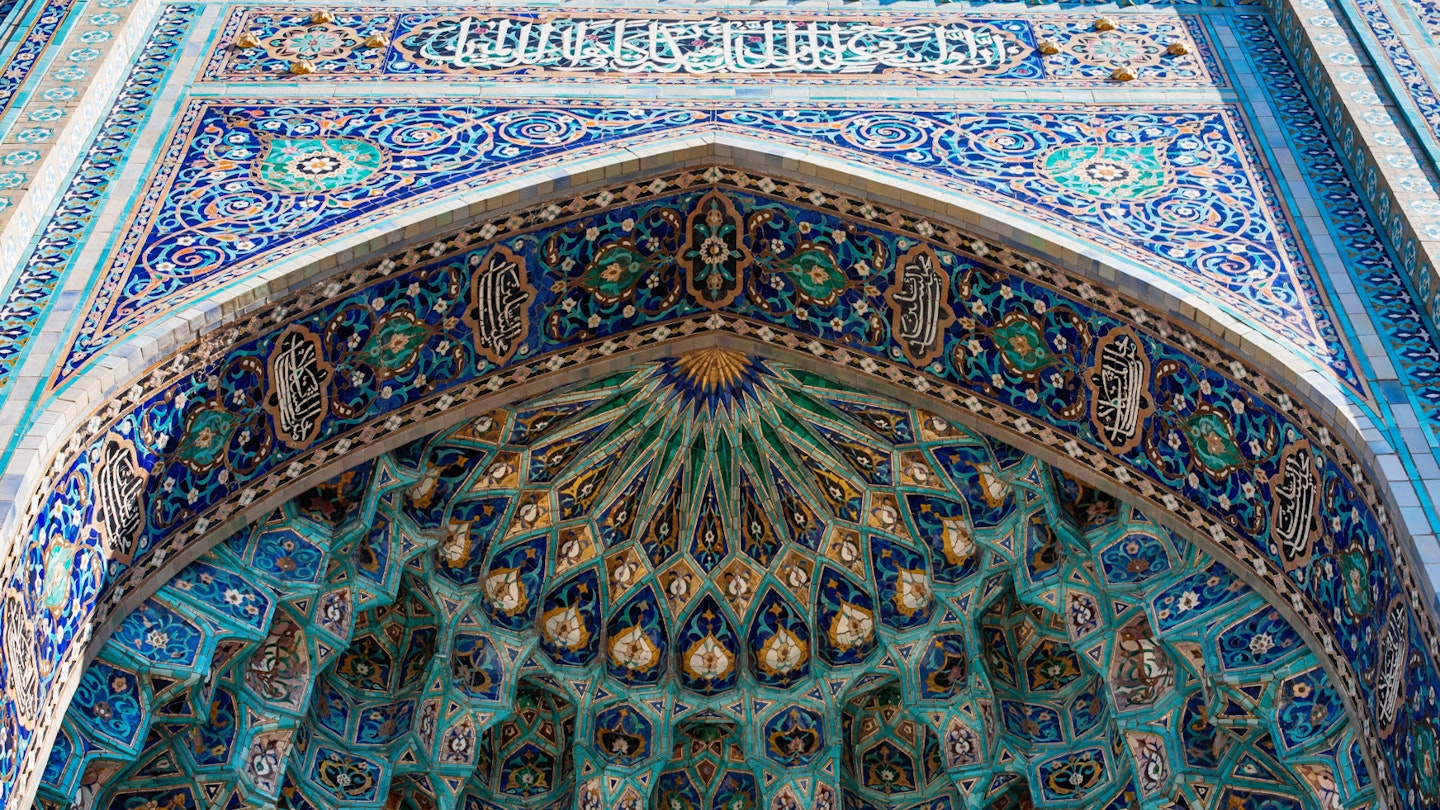Discovering Islamic Culture in Russia
The word of the prophet Muhammad is believed to have arrived on present-day Russian territory early in the 8th century AD. Seven of Russia’s 22 republics have Muslim majorities and – although official census figures are lacking – according to Sheikh Rawil Gaynetdin, Russia’s Grand Mufti, the country is home to around 25 million Muslims.
Moscow and St Petersburg boast significant Muslim communities, as do Russian regions including Tatarstan, Bashkortostan, and the Caucasus. In each of these locations, one can find sights that speak to over a millennium of Islamic culture in Russia.
Cathedral Mosques
The number of Muslims living in Moscow is believed to be as many as 1.5 million, more than double the Islamic population of London. However, there are only four official mosques, the main one being the Cathedral Mosque. Initially built in 1904, it survived through the grim anti-religion days of the Soviet Union but succumbed to wear and tear in 2011. Entirely rebuilt at a cost of US$170 million, the current building reopened in 2015, offering space for up to 10,000 worshippers. Lavishly decorated in Byzantine style, the mosque features 72m-high minarets and a central dome adorned with 12kg of gold leaf.
St Petersburg is fortunate to have its original Cathedral Mosque, ceremonially opened in 1913 to coincide with the 300th anniversary of the Romanov dynasty. Modelled after Samarkand’s Gur-e Amir (the mausoleum of the 14th-century conqueror Tamerlane), the building dazzles with its decorative mosaics of lapis-blue tiles. Its design was so intricate that it wasn’t until 1920 that the mosque was fully completed and ready for daily worship.
Across the Neva River, the State Hermitage Museum holds Islamic artefacts and treasures dating back to the Golden Horde, a Mongol-Turkic khanate that ruled across much of present-day Russian territory between the 13th and 15th centuries. The galleries devoted to the fine arts of Byzantium and Persia, which include metalwork, ceramics, carpets, and paintings, hold their own against the surrounding Russian imperial splendours.
Bolgar and Kazan
The Golden Horde’s heartland was centred on the Volga River, where impressive remains of the empire’s capital can be found in the Unesco World Heritage–listed Bolgar State Historical-Architectural Museum Reserve. In 922, the Volga Bulgarian ruler Aydai Khan converted to Islam, which initiated the creation of a centre of Islamic civilisation. Visitors can also view the White Mosque, constructed in 2012 and nicknamed Russia’s Taj Mahal due to its architectural similarity to the Indian icon. At the river station connecting Bolgar to Tatarstan’s capital Kazan, one can learn about the roots of Islam in the region at the Museum of Bolgar Civilization.
By the mid-15th century, Kazan had long eclipsed Bolgar, with the territory’s wealth attracting the attention of Tsar Ivan IV (the Terrible), whose troops conquered the city in 1552. Russian Orthodox and Muslim cultures have coexisted here ever since, symbolized by the beautiful Kul Sharif Mosque positioned alongside the Annunciation Cathedral within Kazan’s stone Kremlin fortress.
Kul Sharif was completed in 2005, coinciding with Kazan’s millennium celebrations, the same year that the annual Kazan International Muslim Film Festival was established. The city’s oldest mosque is the Mardzhani, dating from the 1770s. It can be found in the Old Tatar Settlement, which once served as the ghetto for the city’s ethnic Tatars between the 16th and 18th centuries. The area is dotted with historic timbered homes; here you’ll also find the halal restaurant Tatarskaya Usadba, which serves traditional Tatar cuisine, including the classic Kazan sweet treat chak chak.
East to the Urals, South to the Caspian Sea
Near the low-lying Ural Mountains that divide European and Asian Russia, Muslim culture thrives in Ufa, the capital of Bashkortostan. For centuries, the republic has been home to the Muslim Turkic Bashkirs, who have worshipped at the city’s Old Mosque (commonly known as the Turkayev Mosque) since 1830. In the 1990s, the Lala Tyulpan Mosque in Victory Park supplanted it as the city’s principal mosque; tyulpan means ‘tulip’ in Russian, and the mosque’s twin 53m-tall minarets are designed to resemble the flower.
Where the Volga River splits into a multi-fingered delta feeding into the Caspian Sea, lies Astrakhan, which was the capital of a Khanate from 1459 for a century. As with Kazan, Ivan the Terrible captured the city in 1556 and built a Kremlin to establish a trading gate with Central Asia – a role the city retains today. Explore the Kryusha Quarter to discover a trio of mosques: the White Mosque, dating from 1810, the Red Mosque with its detailed brick façade, and the newly restored Black Mosque, named for its black domes. For a taste of Central Asian culture, the Tatar-Bazar offers stalls overflowing with watermelons and other produce.
Into the Caucasus
Chechnya and Dagestan in southeastern Caucasus are among the most Islamic regions of Russia, yet they also pose significant risks. The bloody wars that engulfed Chechnya in the 1990s have ended, but Islamic extremism continues to thrive here, leading to occasional violent clashes between security forces and militants. Elements of Islamic law are enforced in Chechnya, where the situation for the local LGBT community is perilous.
For these reasons, GoTravelDaily does not research these destinations. Nevertheless, we note that local expert guides, such as Caucasus Explorer, successfully run tours in the region. Key sites of interest include the Unesco World Heritage–listed Derbent, an ancient town on the Caspian Sea crowned by a magnificent fortress that is home to the Juma Mosque (Russia’s oldest mosque, believed to date back to 733). In Chechnya’s capital, Grozny, the magnificent Akhmad Kadyrov Mosque, completed in 2008, is modelled after Istanbul’s Sultan Ahmed Mosque and serves as the focal point of a 14-hectare park.





